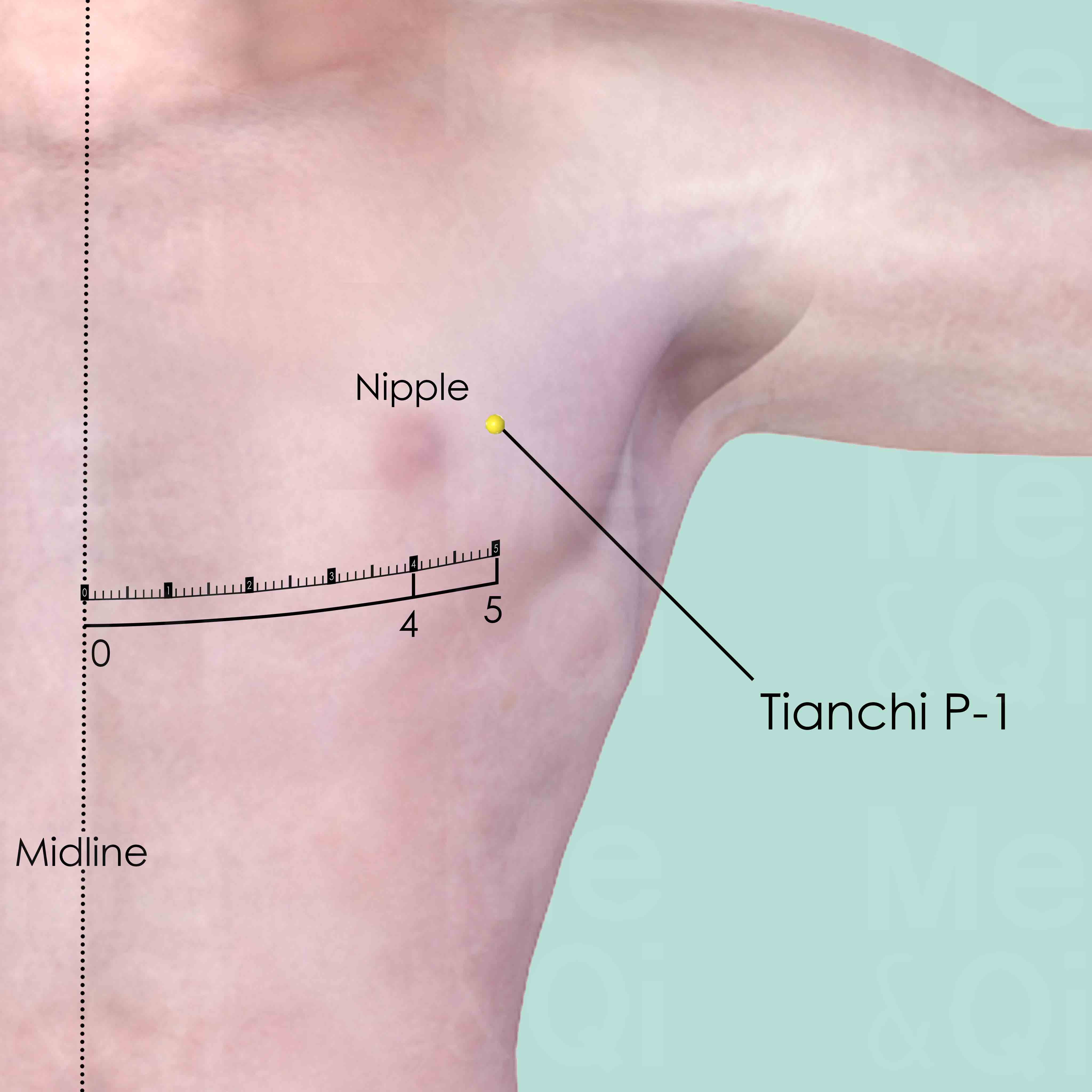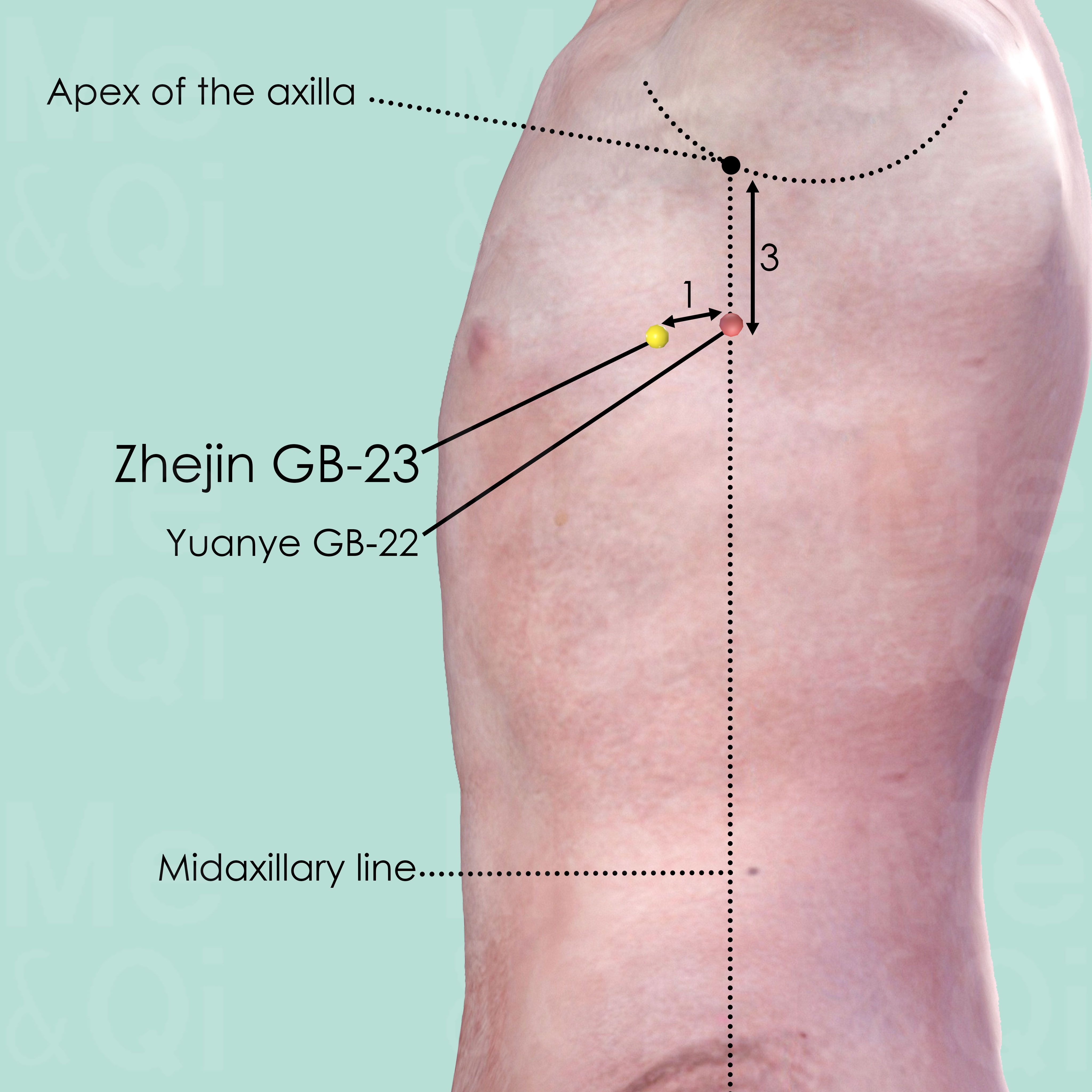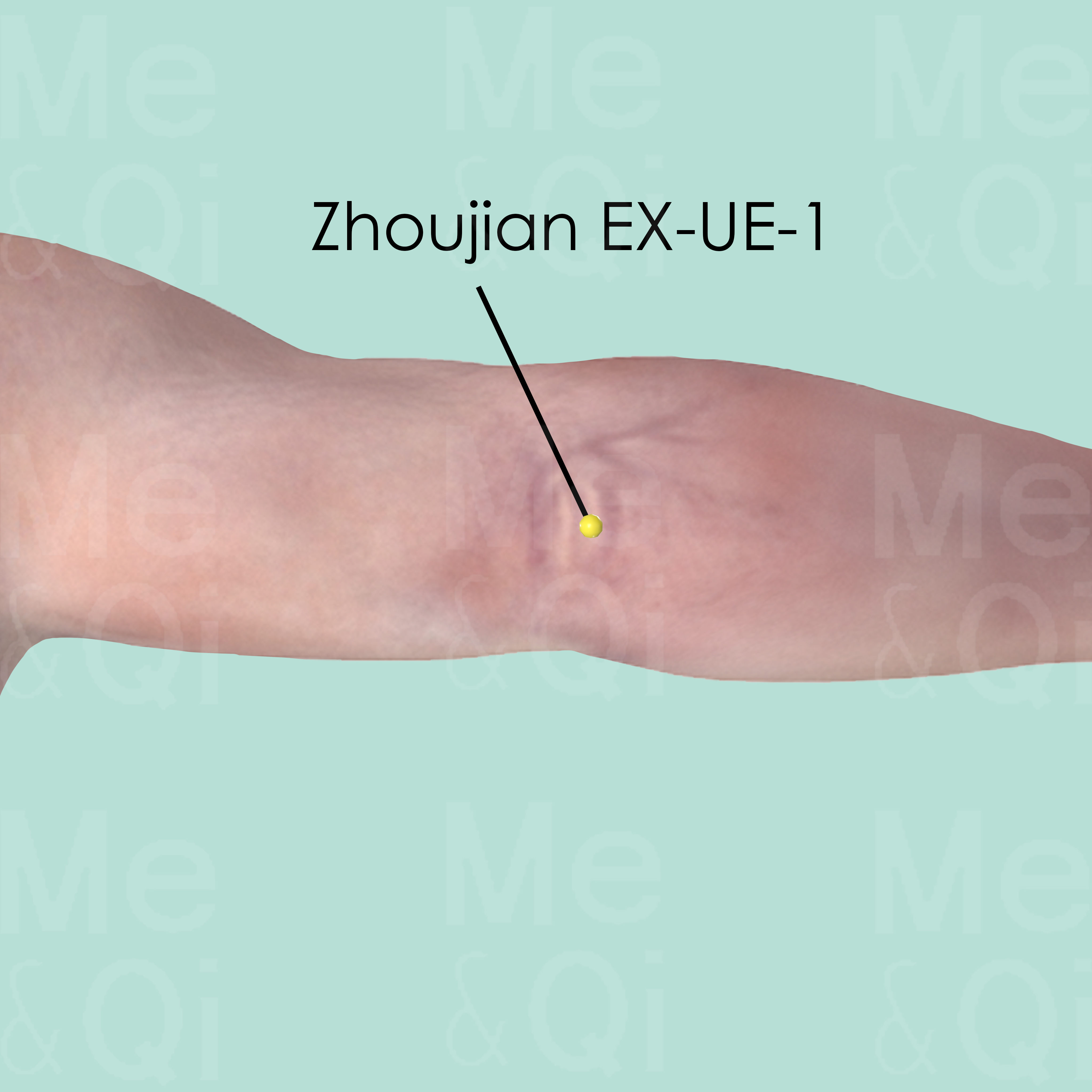Scrofulaaccording to TCM
Symptom families: Tuberculosis, Neck Disorders and Symptoms
Parent symptom: Tuberculosis
What is Scrofula?
Neck tuberculosis, also known as neck tuberculosis, is a form of tuberculosis that affects the lymph nodes in the neck. It’s characterized by the gradual enlargement of these nodes, which can become chronic and may suppurate, leading to sinus tract formation.
This condition is often a secondary development from tuberculosis elsewhere in the body, representing a localized manifestation of a more systemic infection.
How Does TCM View Scrofula?
From a Traditional Chinese Medicine standpoint, scrofula is understood as an accumulation of pathogenic factors like Toxic Heat and Phlegm or Dampness in the neck region.
TCM practitioners would look beyond the neck, assessing the entire body for imbalances in Qi and Blood, and seek to identify the particular disharmony causing the symptoms, be it a Deficiency or an Excess.
Causes of Scrofula According to TCM
TCM attributes the causes of scrofula to internal disharmonies that lead to the formation of toxic nodules. Primary among these is Qi And Blood Stagnation due to emotional stress or dietary irregularities.
Additionally, a Qi Deficiency could lead to a weakened immune system, making the body more susceptible to the accumulation of pathological factors. A TCM diagnosis will typically involve a detailed assessment to identify the unique pattern in each patient, which could include a combination of Qi Deficiency and pathogenic accumulation.
TCM Herbal Formulas for Scrofula
In addressing scrofula, TCM favors formulas designed to vent the membrane source and eradicate the pathogenic accumulation.
A common formula used is Chai Hu Gui Jiang Tang, which utilizes Bupleurum Roots to harmonize the Interior and Exterior of the body and dispel the pathogenic factors from the Gallbladder and Liver meridians. This approach seeks not only to treat the local symptoms in the neck but also to restore systemic balance and immunity.
Explore below some TCM herbal formulas used to address scrofula, organized by formula type.
- By Formula Type
- Formulas that vent membrane source
- Formulas that clear external abscesses and sores
Formulas that vent membrane source
Scrofula can be treated by these formulas if it results from blockages in the body, often manifested as masses or lumps, needing actions that open and resolve these obstructions.
One such formula is Chai Hu Gui Jiang Tang, with bupleurum root as a key herb.
Formulas that clear external abscesses and sores
Scrofula can be treated by formulas that clear external abscesses and sores if it is due to localized infections or inflammations on the skin.
One such formula is San Zhong Kui Jian Tang, with phellodendron bark as a key herb.
Acupoints for Scrofula
TCM also prescribes acupuncture as part of the treatment for neck tuberculosis.
Points along the Large Intestine Channel such as Binao LI-14 and Futu LI-18 are selected to resolve Phlegm and benefit the throat. In the Stomach Channel, Daying ST-5 and Qishe ST-11 may be used to expel Wind and descend Qi, easing neck symptoms.
The Triple Burner Channel's Naohui TB-13 and Tianjing TB-10 can help remove obstructions and Phlegm. Each acupoint is chosen based on its traditional indication and the individual's specific condition to create a synergistic effect with herbal treatment.
Explore below some acupoints used to address scrofula, organized by meridian.
- By Meridian
- Large Intestine Channel
- Stomach Channel
- Triple Burner Channel
- Pericardium Channel
- Small Intestine Channel
- Extra Points: Head and Neck (EX-HN)
- Gall Bladder Channel
- Extra Points: Upper Extremities (EX-UE)
- Heart Channel
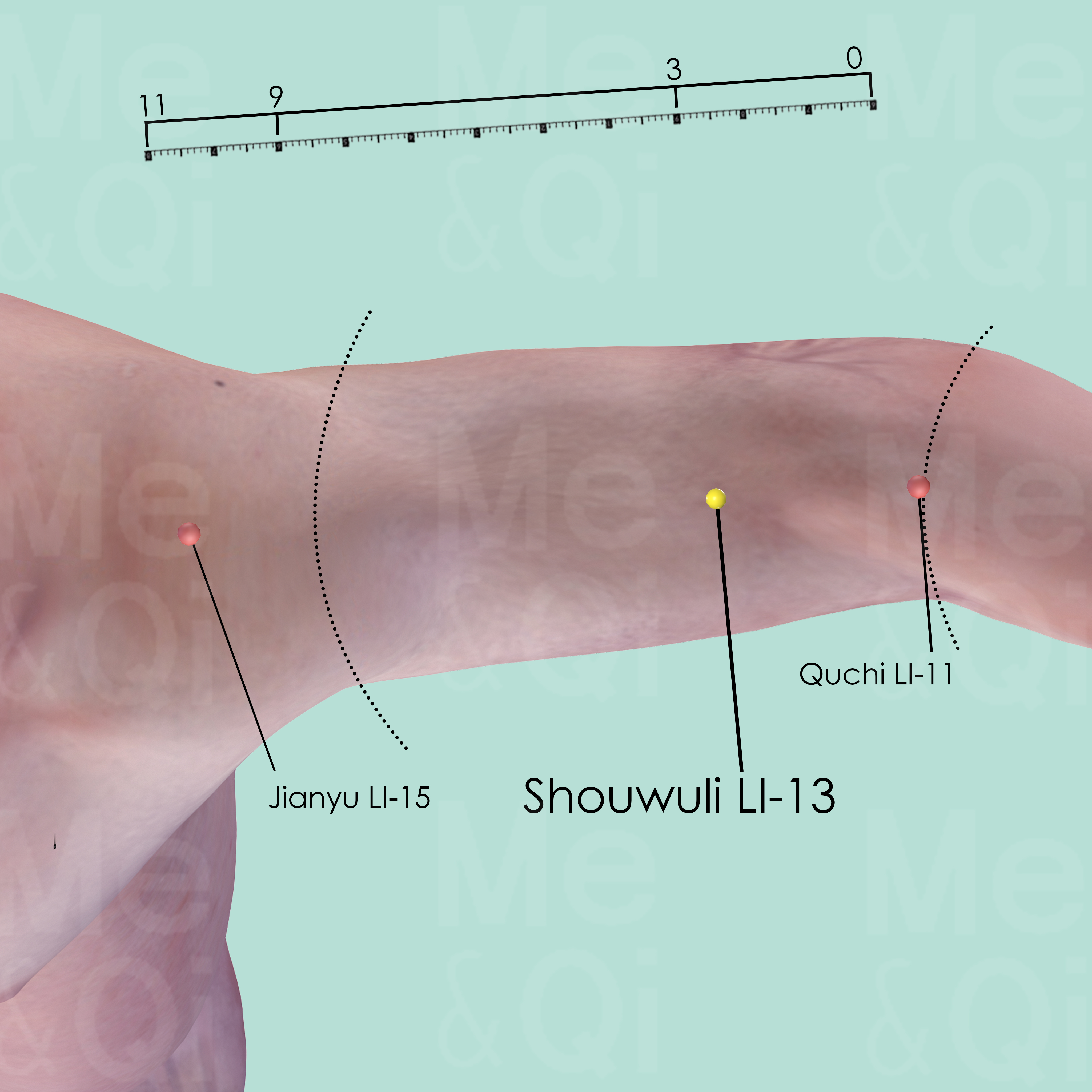
Shouwuli LI-13
Superior to the lateral epicondyle of the humerus, 3 cun above Quchi LI-11, on the line connecting Quchi LI-11 and Jianyu LI-15.
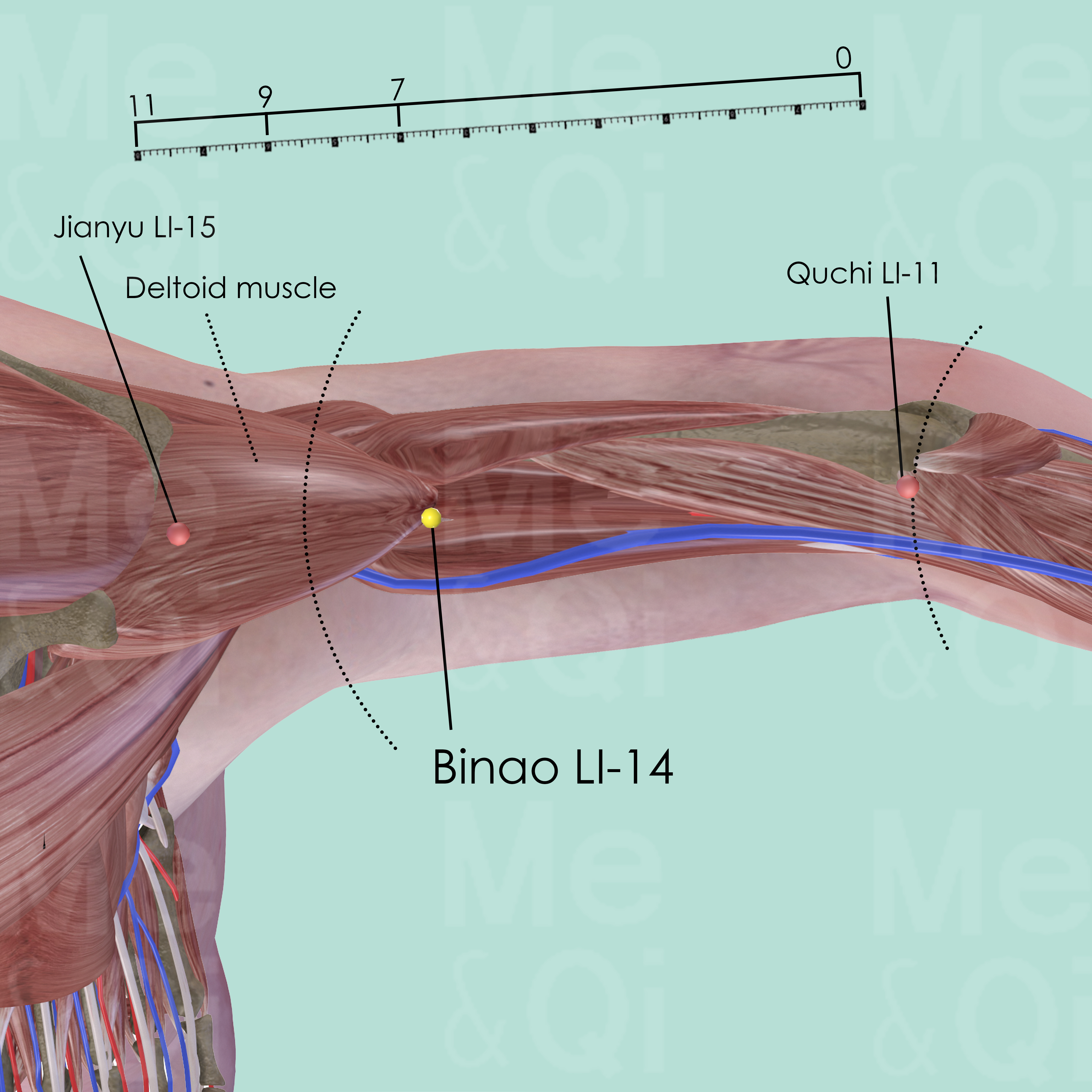
Binao LI-14
On the radial side of the humerus, superior to the lower end of deltoid muscle, on the line connecting Quchi LI-11 and Jianyu LI-15, 7 cun proximal to Quchi LI-11.
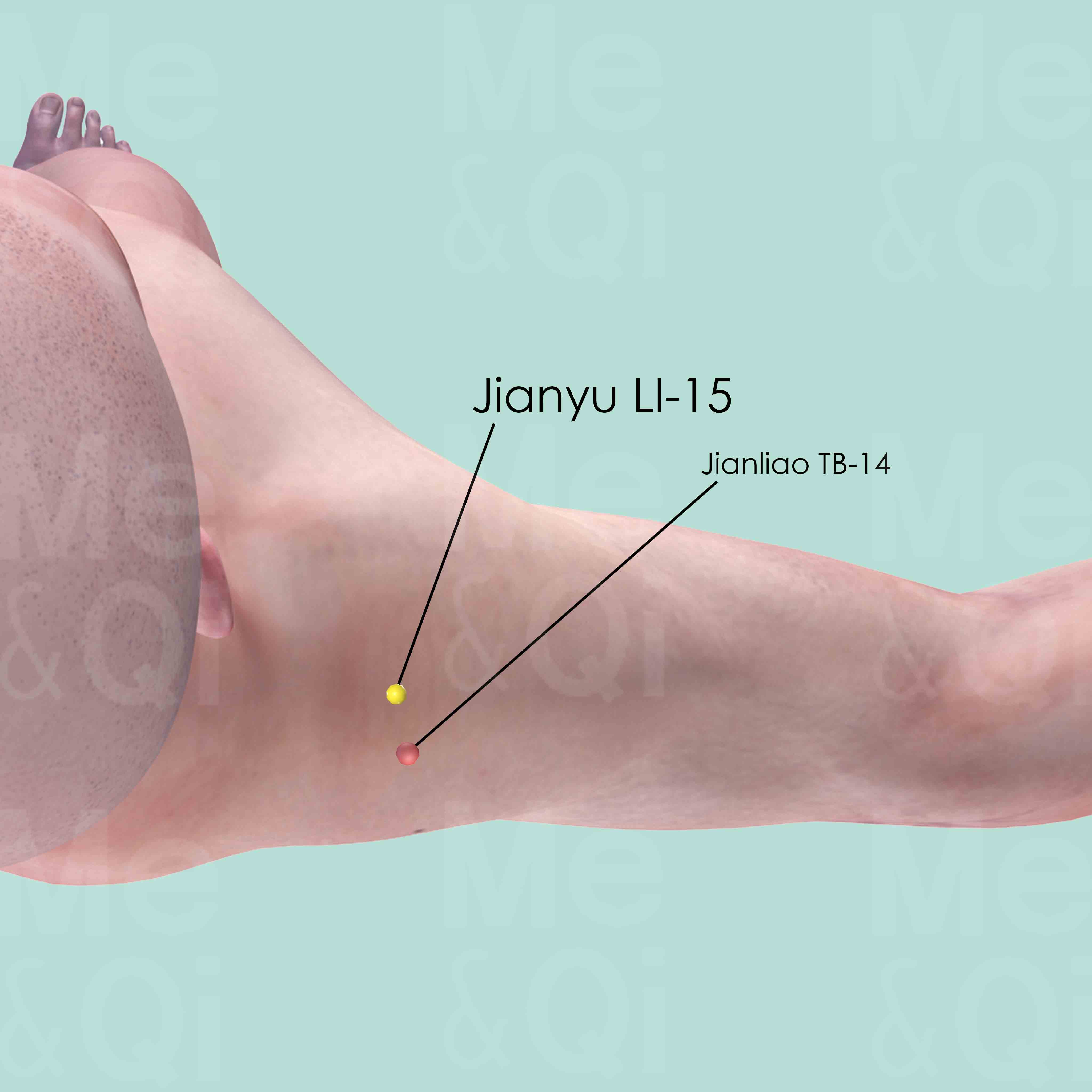
Jianyu LI-15
Jianyu LI-15 is located antero-inferior to the acromion, between the clavicular and acromial portions of the deltoid muscle.
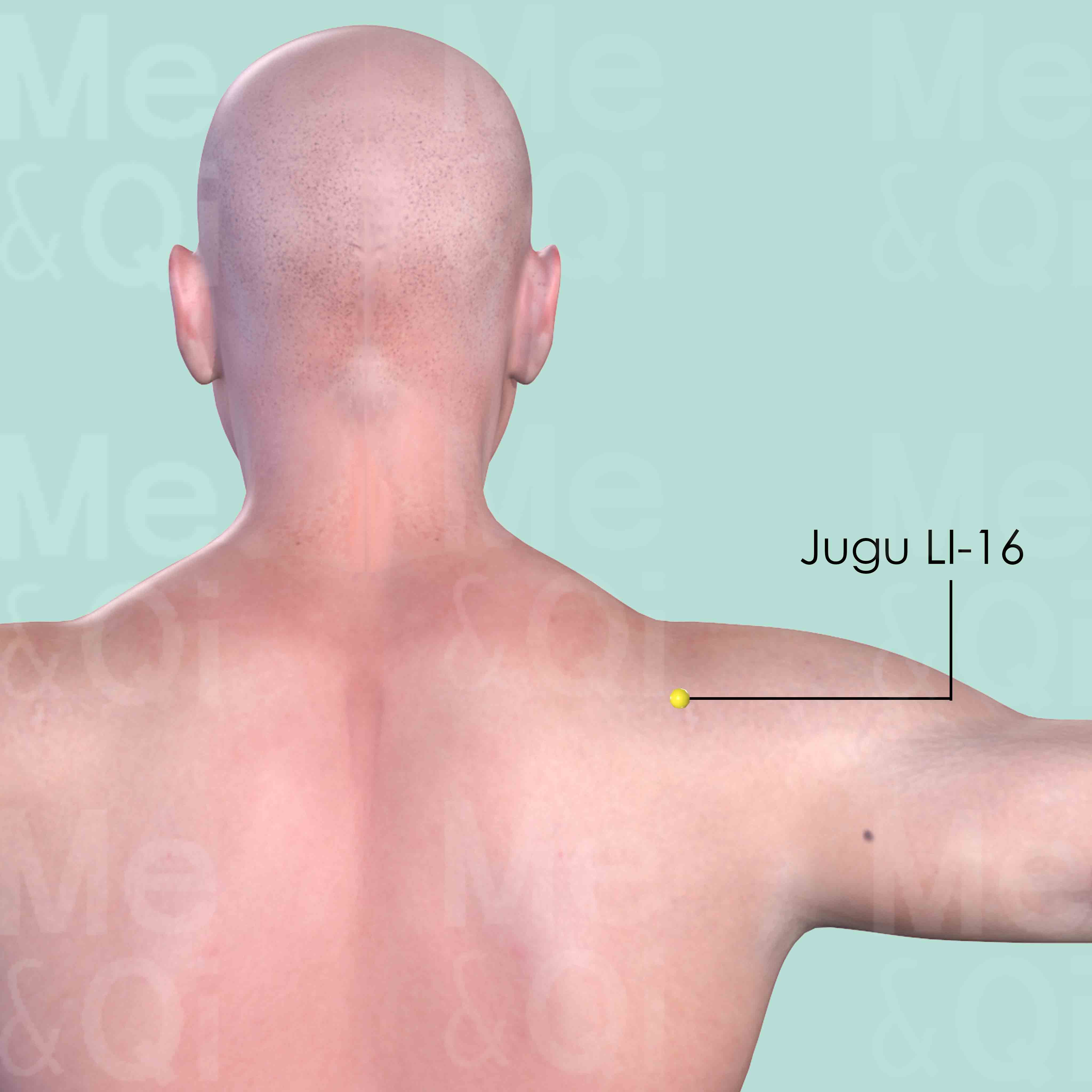
Jugu LI-16
In the upper aspect of the shoulder, in the depression between the acromio-clavicular joint and the scapular spine.
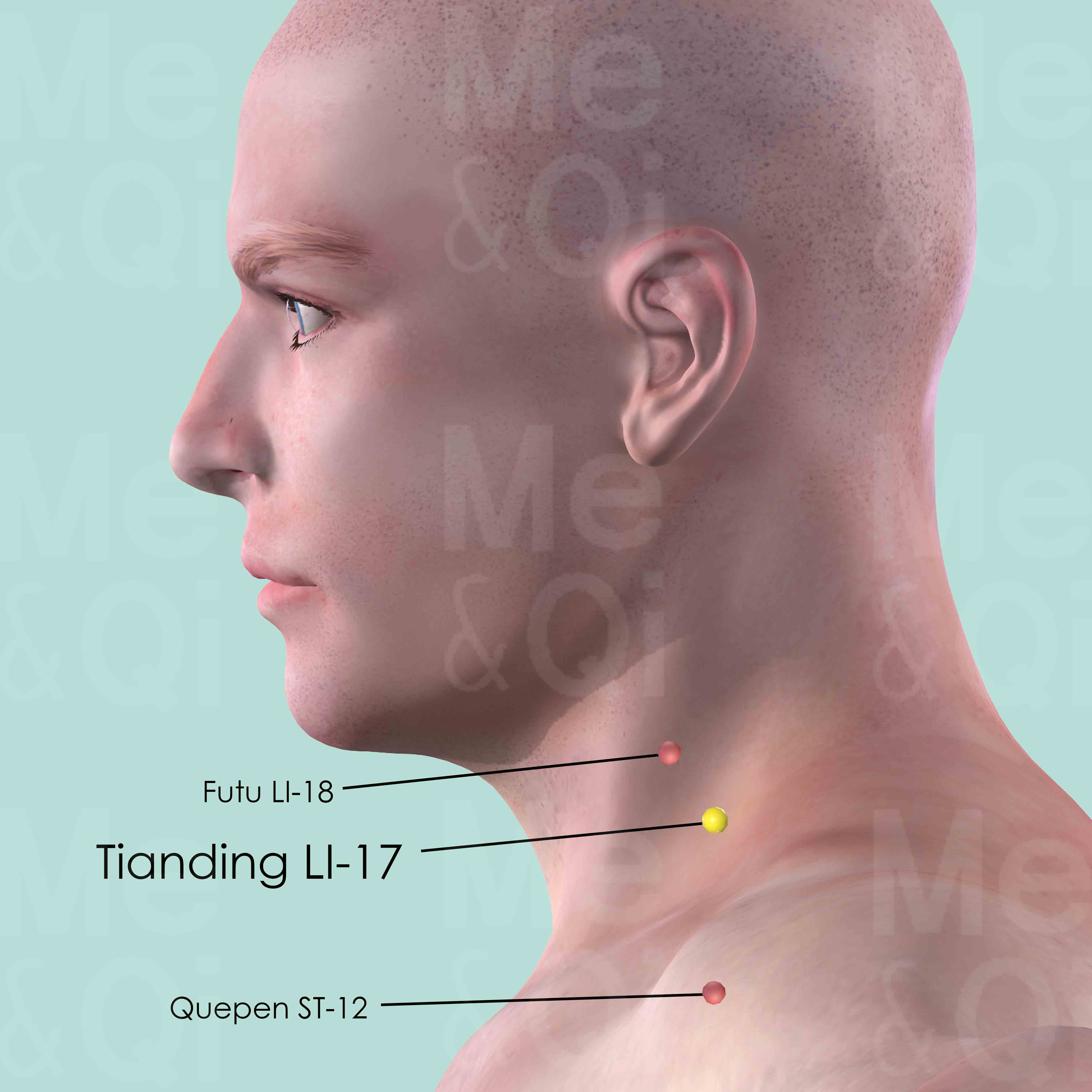
Tianding LI-17
Tianding LI-17 is located on the lateral side of the neck, on the posterior border of the sternocleidomastoid muscle, superior to Quepen ST-12 at the midpoint of the supraclavicular fossa. It is 1 cun below Futu LI-18 which is between the two head of the sternocleidomastoid muscle.
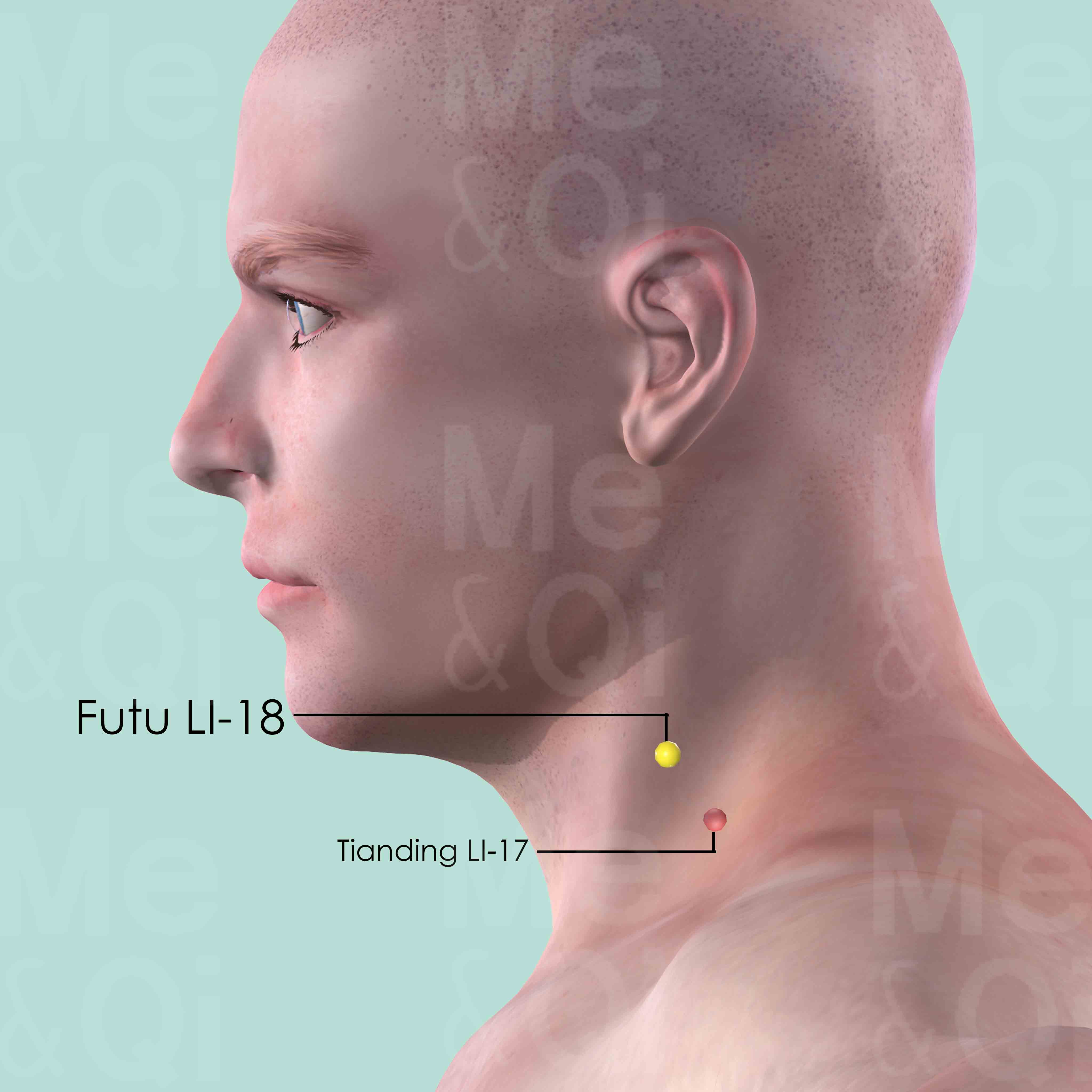
Futu LI-18
On the lateral side of the neck, level with the tip of Adam's apple, between the sternal head and clavicular head of sternocleidomastoid muscle.
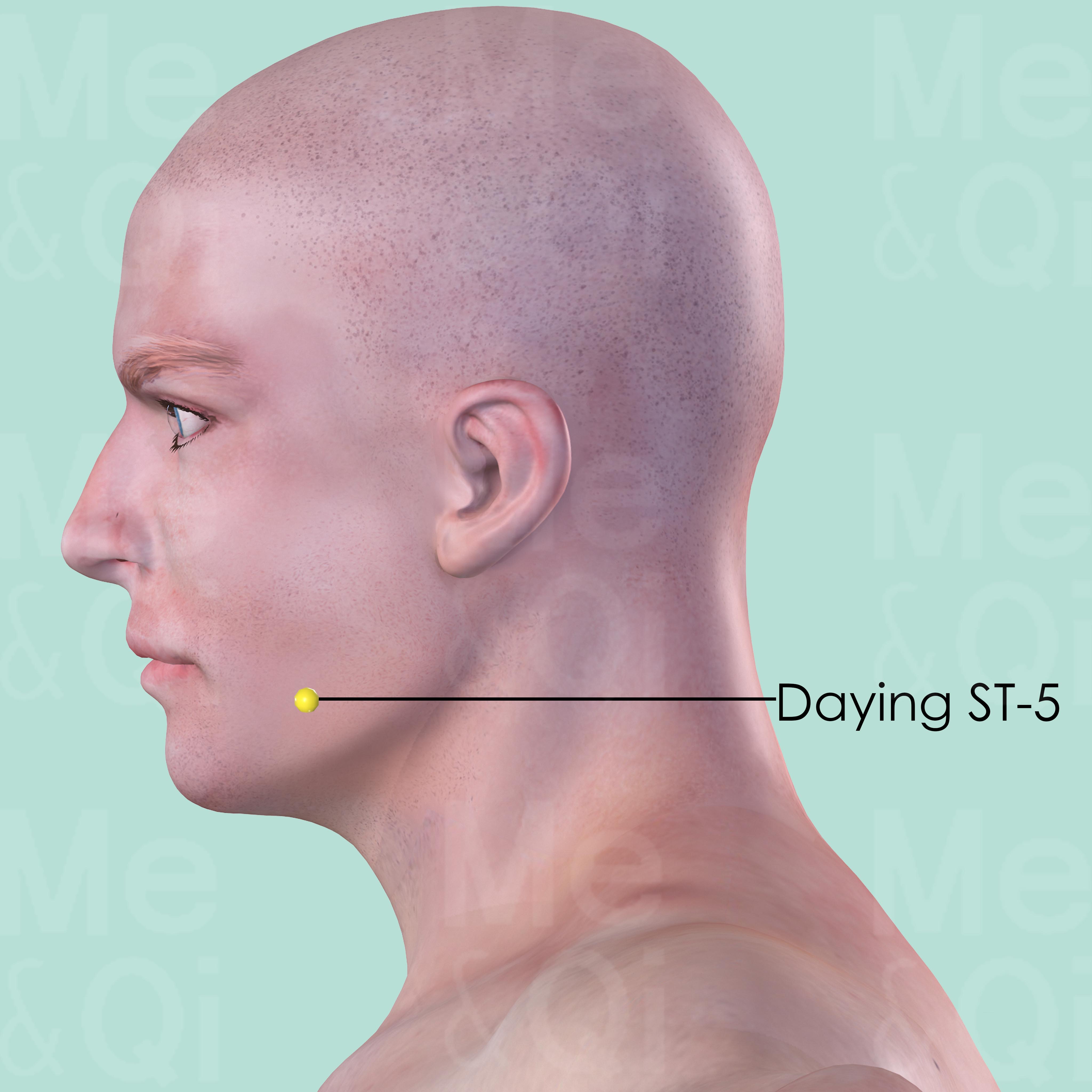
Daying ST-5
On the lateral mandible, on the anterior border of masseter muscle, in the groove-like depression appearing when the cheek is bulged.
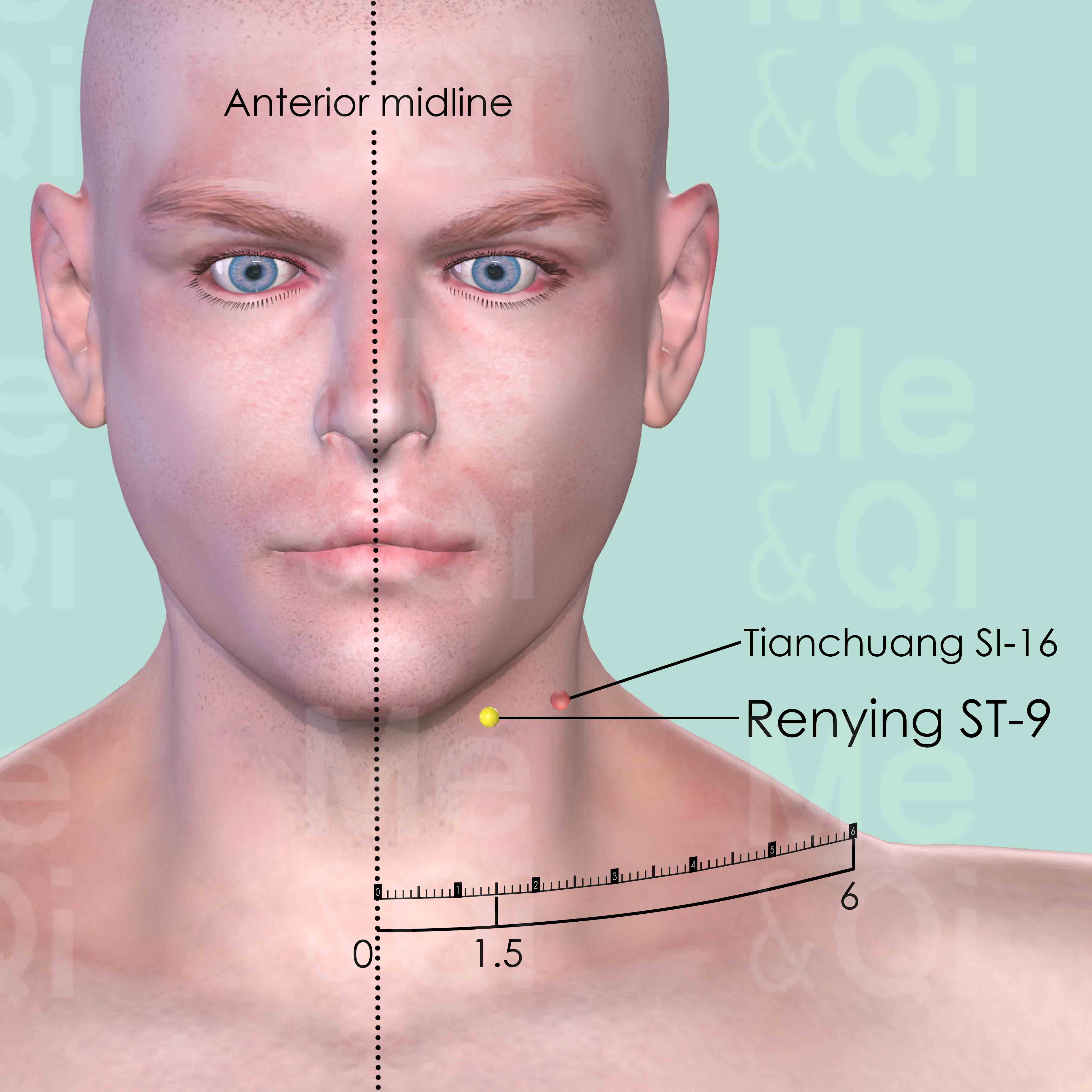
Renying ST-9
Level with the tip of Adam's apple, 1.5 cun lateral to the anterior midline, on the anterior border of the sternocleidomastoid muscle.
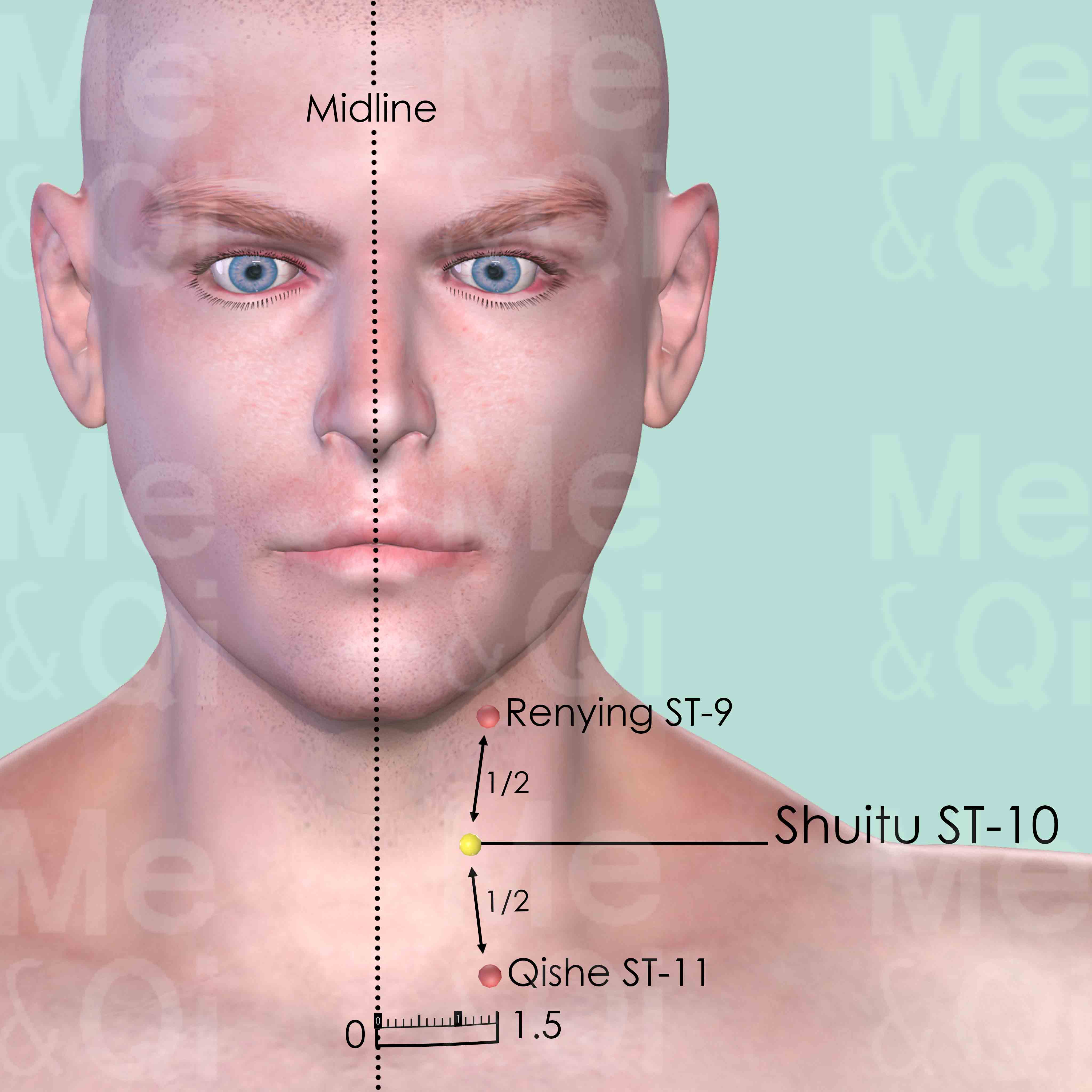
Shuitu ST-10
On the anterior border of sternocleidomastoid muscle, in the middle between Renying ST-9 and Qishe ST-11.
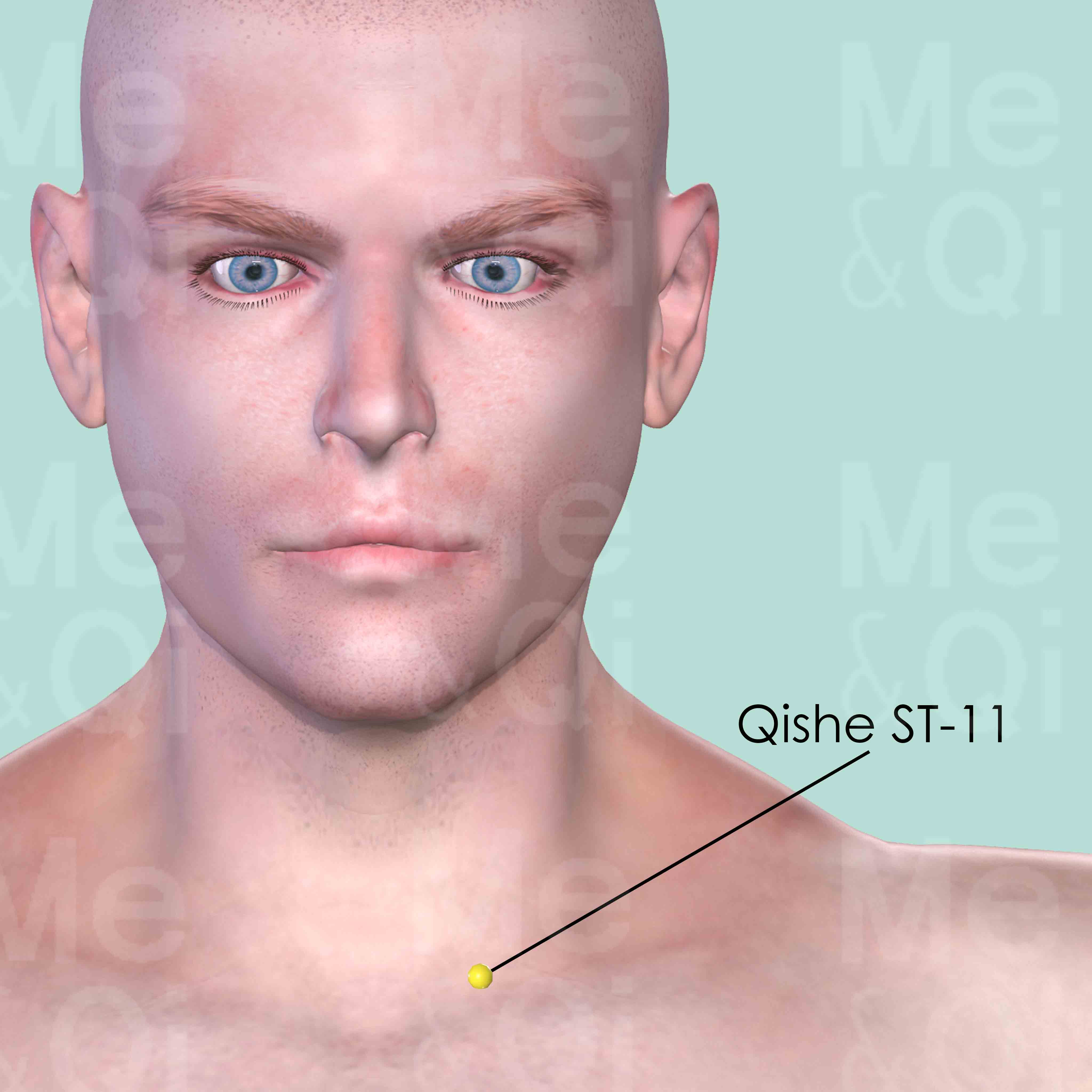
Qishe ST-11
On the upper border of the clavicle, between the tendons of the sternal and clavicular heads of the sternocleidomastoid muscle.
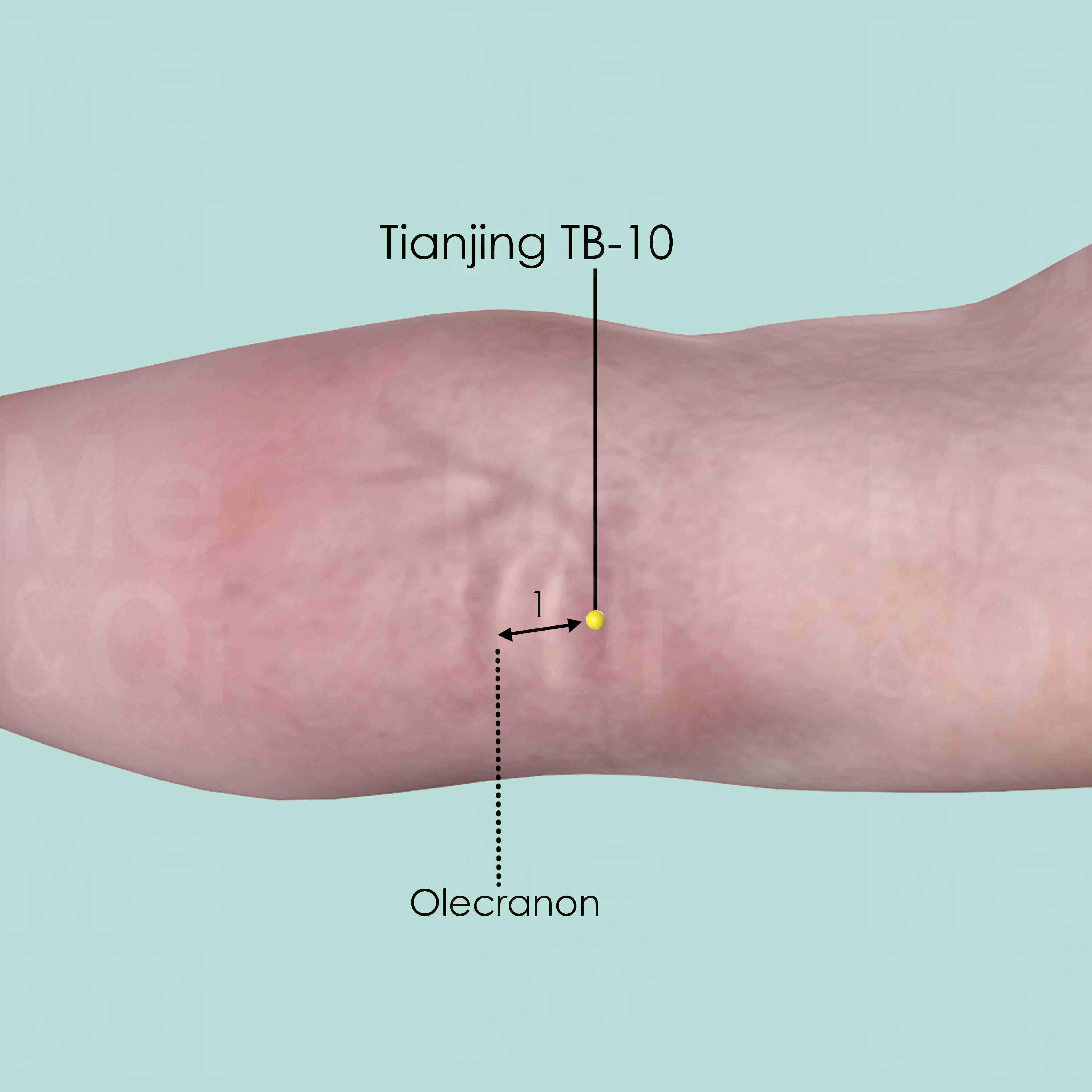
Tianjing TB-10
When the elbow is flexed, Tianjing TB-10 is in the depression about 1 cun superior to the olecranon.
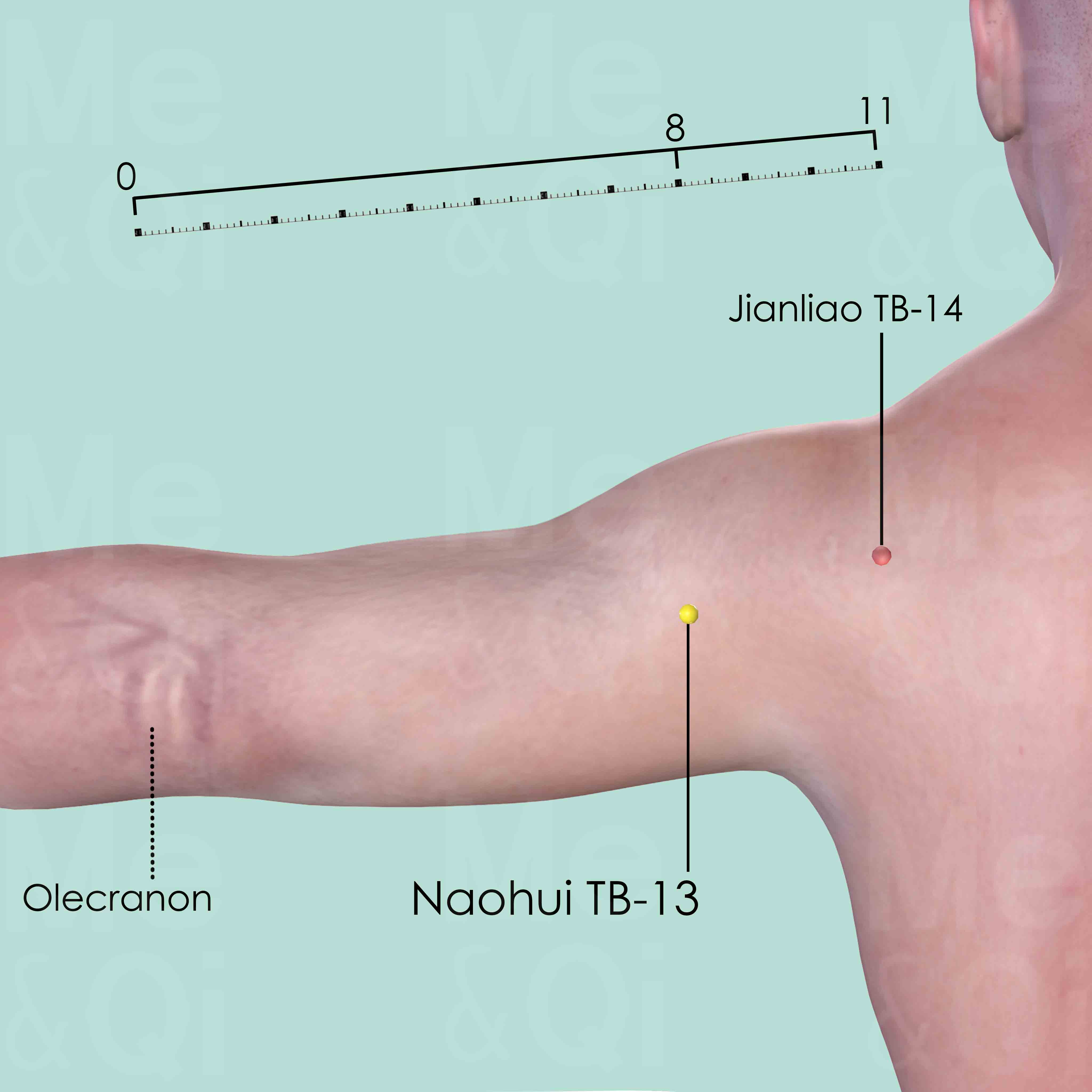
Naohui TB-13
On the line joining Jianliao TB-14 and the olecranon, 3 cun below Jianliao TB-14 which is at the lateral extremity of the acromion. Naohui TB-13 is on the posterior border of deltoid muscle.
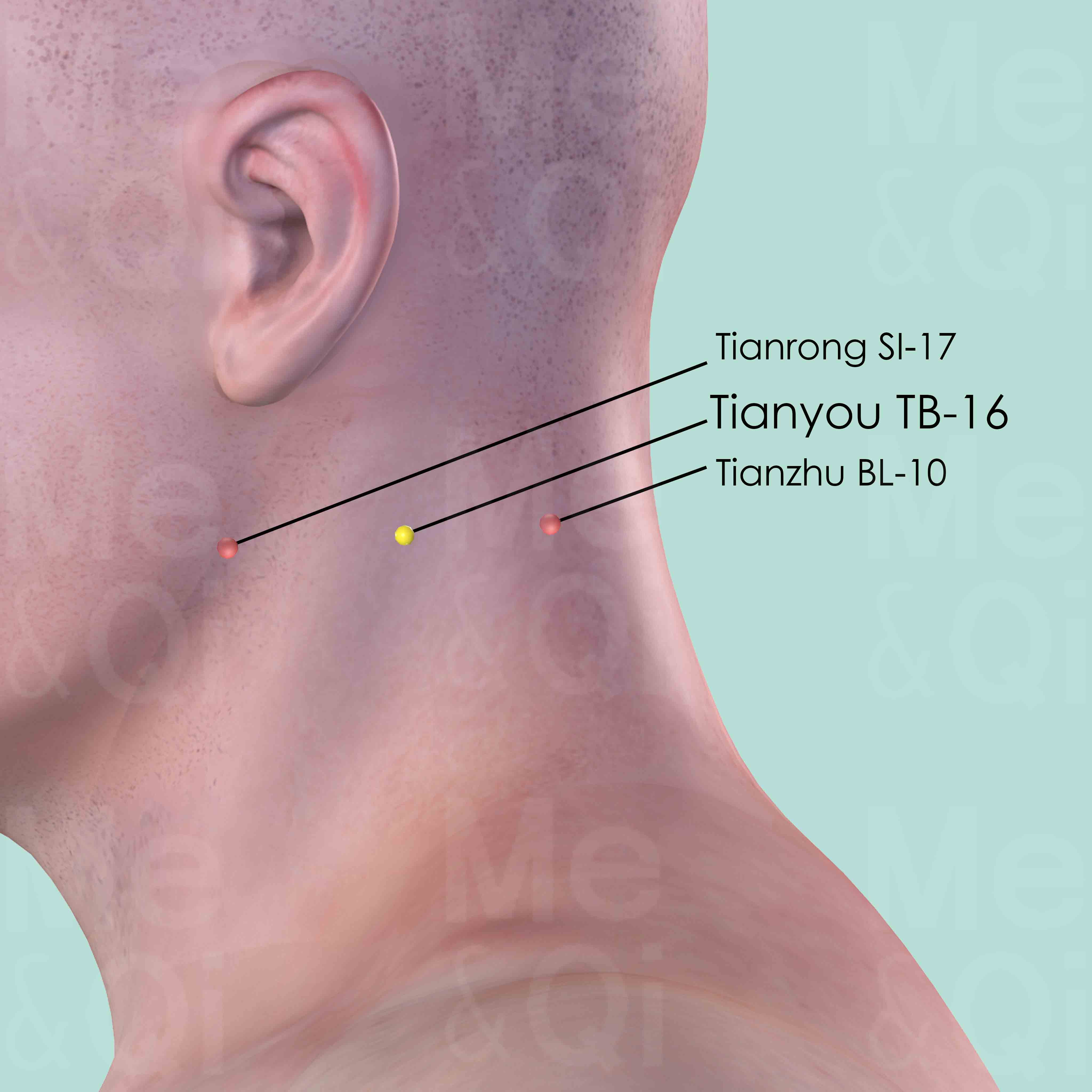
Tianyou TB-16
Posterior and inferior to the mastoid process, on the posterior border of sternocleidomastoid muscle, level with Tianrong SI-17 and Tianzhu BL-10.
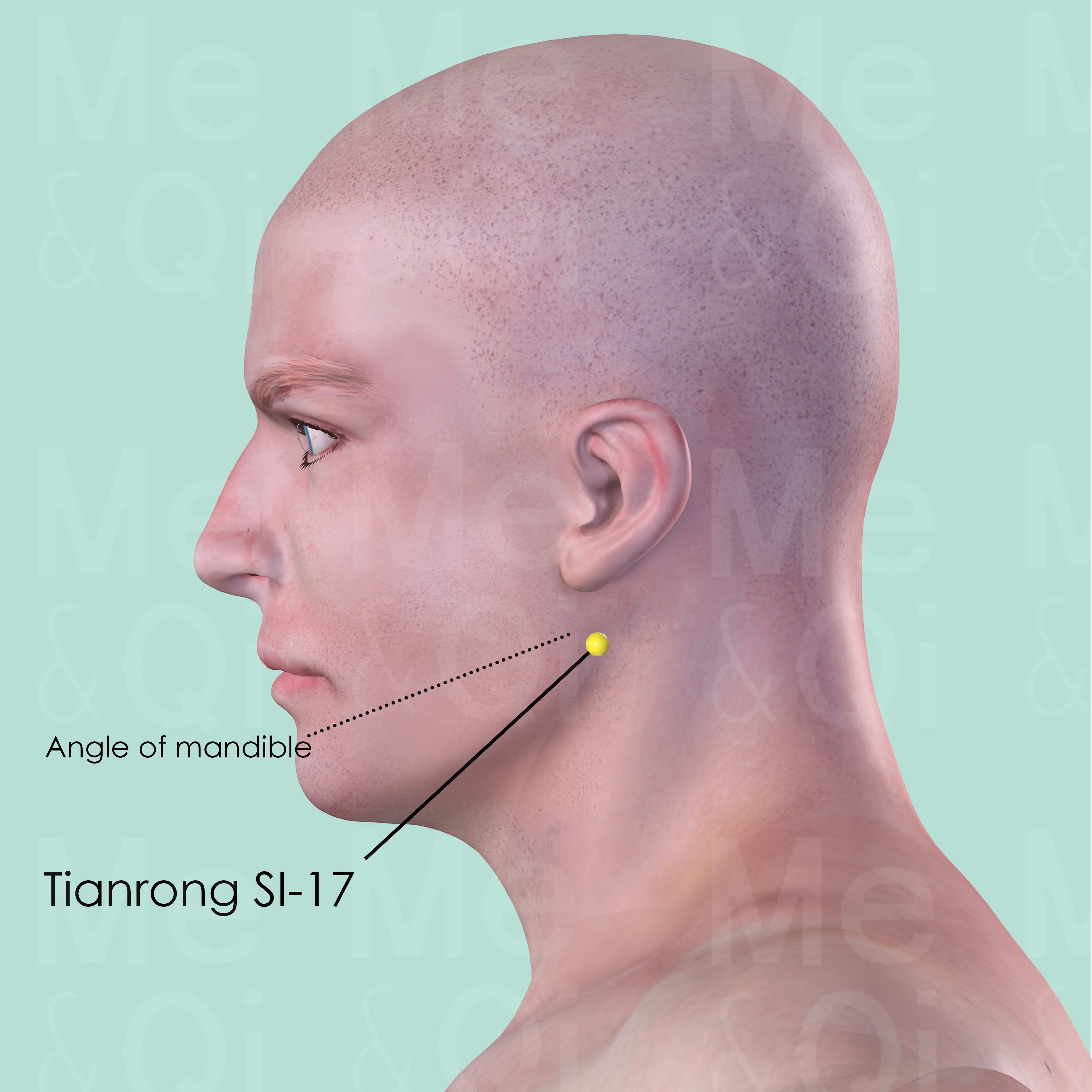
Tianrong SI-17
Posterior to the angle of mandible, in the depression on the anterior border of sternocleidomastoid muscle.
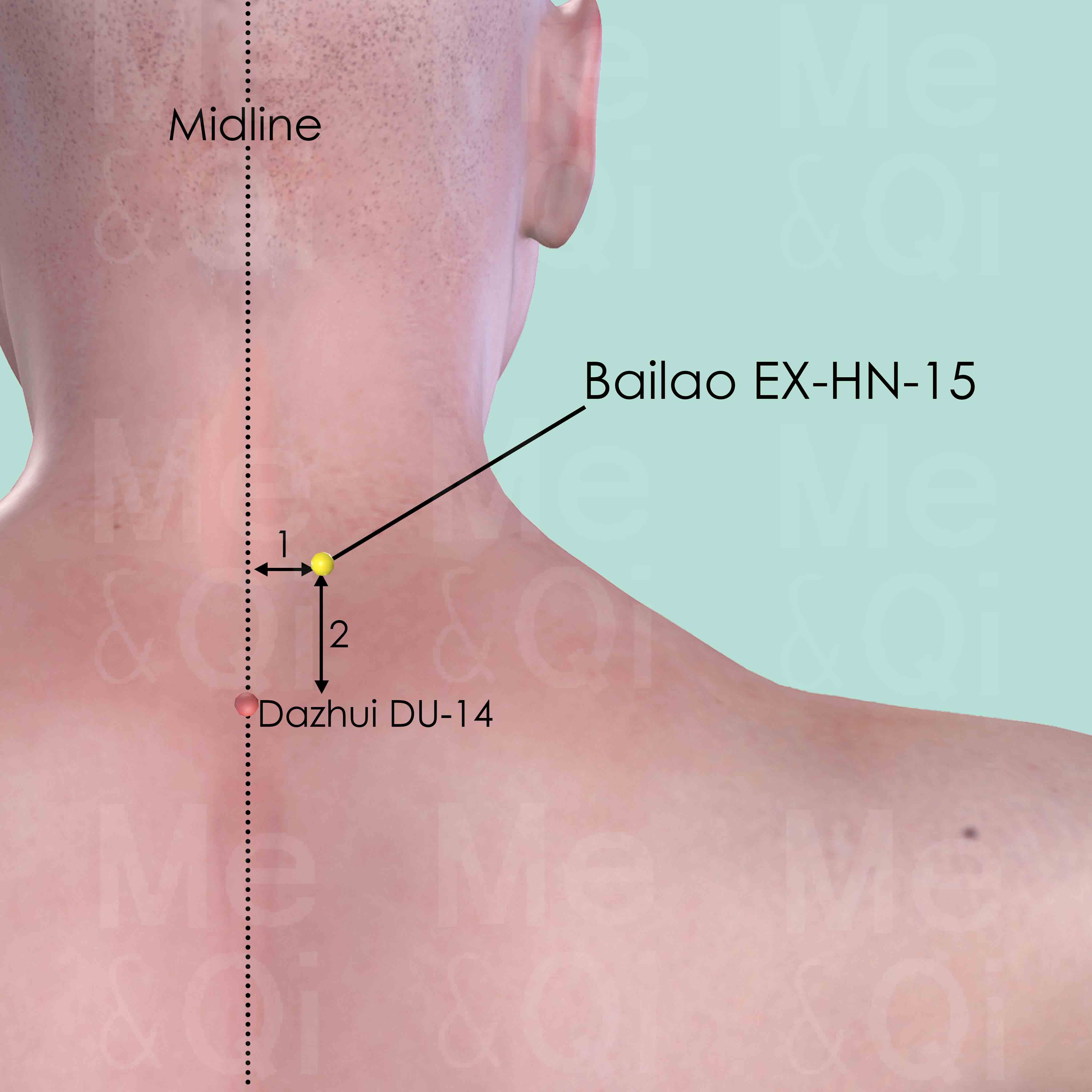
Bailao EX-HN-15
2 cun above the lower border of the spinous process of the 7th cervical vertebra (C7) and 1 cun lateral to the midline.
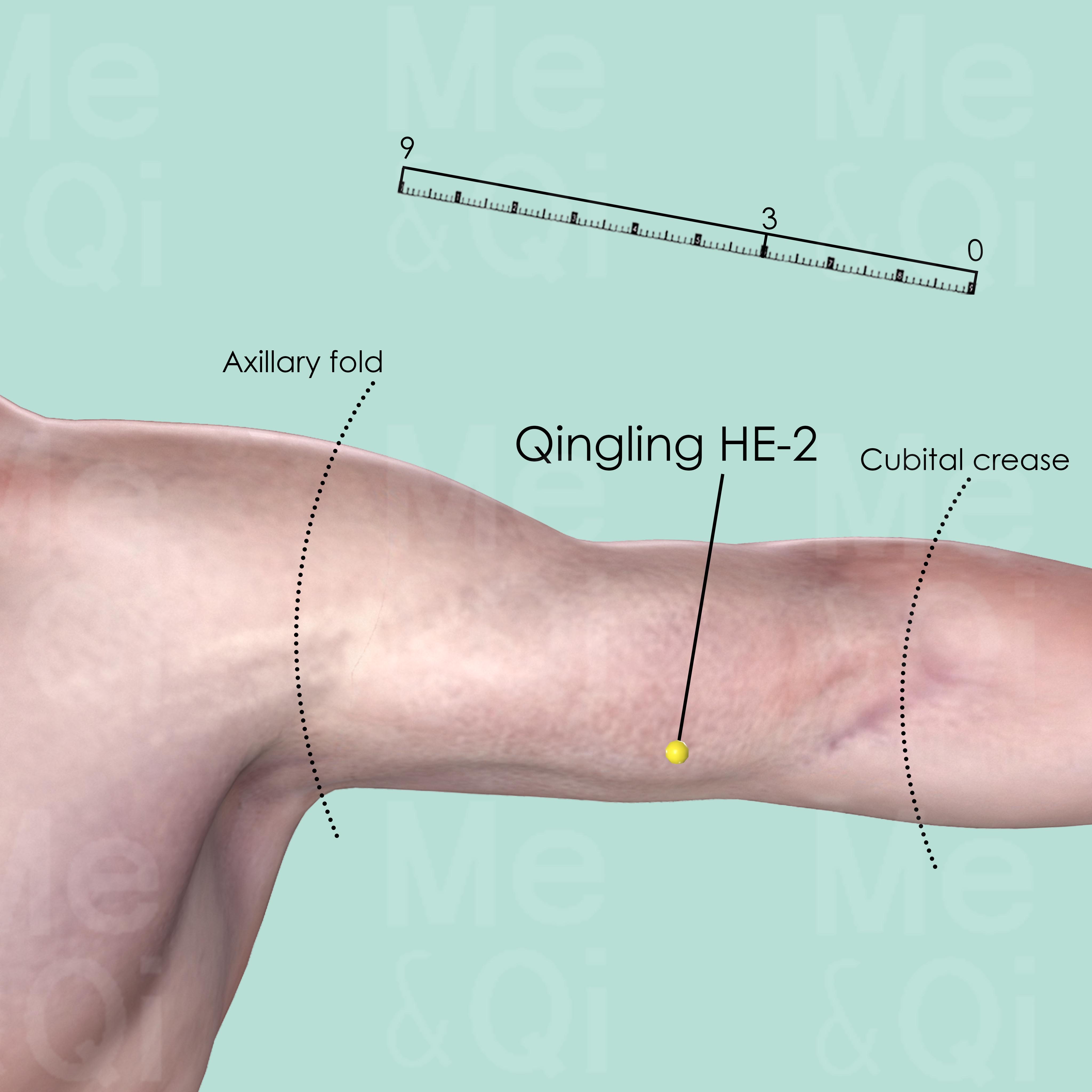
Qingling HE-2
3 cun above the medial end of the transverse cubital crease, in the depression medial to the biceps brachii muscle.
TCM Herbs for Scrofula
Explore below some TCM herbs used to address scrofula, organized by herb category.
- By Herb Category
- Herbs that clear heat and relieve toxicity
- Cool herbs that transform phlegm and stop cough
- Herbs that clear heat and dry dampness
- Herbs that invigorate the blood
- Herbs that clear heat and purge fire and/or clear summer heat
- Herbs that dispel wind and dampness
- Herbs that pacify internal liver wind and stop tremors
- Tonic herbs for yang deficiency
- Tonic herbs for blood deficiency
- Herbs that anchor and calm the spirit
- Laxative herbs that drain downward
- Herbs that regulate qi
- Cool/Acrid herbs that release the exterior
- Warm/Acrid herbs that release the exterior
Herbs that clear Heat and relieve Toxicity
Scrofula can be treated by these herbs if it arises from internal heat and toxic accumulations, aiding in detoxification and cooling the body.
One such herb is Bistort Rhizomes (Quan Shen), which is directly recommended for scrofula.
Other herbs of this category are listed in the table below.
"Herbs that clear Heat and relieve Toxicity" recommended for scrofula
| Herb | Formulas they belong to (if applicable) |
|---|---|
| Bistort Rhizomes (Quan Shen) | Not applicable |
| Castor Beans (Bi Ma Zi) | Not applicable |
| Catclaw Buttercup Roots (Mao Zhao Cao) | Not applicable |
| Chinese Tulip Bulbs (Shan Ci Gu) | Not applicable |
| Semiaquilegia Root Tubers (Tian Kui Zi) | Not applicable |
Cool herbs that transform Phlegm and stop Cough
Scrofula can be treated by these herbs when it is related to heat-phlegm accumulation, aiding in dissolving phlegm and soothing the respiratory system.
One such herb is Clam Shells (Ha Ke), which is directly recommended for scrofula.
Other herbs of this category are listed in the table below.
"Cool herbs that transform Phlegm and stop Cough" recommended for scrofula
| Herb | Formulas they belong to (if applicable) |
|---|---|
| Clam Shells (Ha Ke) | Not applicable |
| Costazia Skeletons (Fu Hai Shi) | Not applicable |
| Fritillary Bulbs (Chuan Bei Mu) | Not applicable |
| Sargassum (Hai Zao) | Not applicable |
Herbs that clear Heat and dry Dampness
Scrofula can be treated by these herbs when caused by excessive dampness and heat within the body, aiming to restore balance by drying dampness and clearing heat.
One such herb is Phellodendron Bark (Huang Bo), a key herb in some formulas recommended for scrofula, like San Zhong Kui Jian Tang.
Other herbs of this category are listed in the table below.
"Herbs that clear Heat and dry Dampness" recommended for scrofula
Herbs that invigorate the Blood
Scrofula can be treated by these herbs when it stems from stagnation or poor circulation of blood, helping to improve blood flow and alleviate related discomfort.
One such herb is Chinese Sage Herb (Shi Jian Chuan), which is directly recommended for scrofula.
Other herbs of this category are listed in the table below.
"Herbs that invigorate the Blood" recommended for scrofula
| Herb | Formulas they belong to (if applicable) |
|---|---|
| Chinese Sage Herb (Shi Jian Chuan) | Not applicable |
| Cockle Shells (Wa Leng Zi) | Not applicable |
Herbs that clear Heat and purge Fire and/or clear Summer Heat
Scrofula can be treated by these herbs when it arises from excessive internal heat or fire, aiding in cooling the body and balancing internal temperature.
One such herb is Anemarrhena Rhizomes (Zhi Mu), a key herb in some formulas recommended for scrofula, like San Zhong Kui Jian Tang.
Other herbs of this category are listed in the table below.
"Herbs that clear Heat and purge Fire and/or clear Summer Heat" recommended for scrofula
| Herb | Formulas they belong to (if applicable) |
|---|---|
| Anemarrhena Rhizomes (Zhi Mu) | San Zhong Kui Jian Tang |
| Heal-All Spikes (Xia Ku Cao) | Not applicable |
Herbs that dispel Wind and Dampness
Scrofula can be treated by these herbs when it is due to the invasion or accumulation of wind and dampness, which often affects the muscles and joints.
One such herb is Honeycomb (Feng Fang), which is directly recommended for scrofula.
Other herbs of this category are listed in the table below.
"Herbs that dispel Wind and Dampness" recommended for scrofula
| Herb | Formulas they belong to (if applicable) |
|---|---|
| Honeycomb (Feng Fang) | Not applicable |
| Viper Snakes (Fu she) | Not applicable |
Herbs that pacify Internal Liver Wind and stop Tremors
Scrofula can be treated by these herbs when caused by internal wind from Liver disharmony, often manifesting in symptoms like spasms or tremors.
One such herb is Centipedes (Wu Gong), which is directly recommended for scrofula.
Tonic herbs for Yang Deficiency
Scrofula can be treated by these herbs in situations of diminished Yang energy, aiming to warm and activate the body's functions.
One such herb is Deer Bones (Lu Gu), which is directly recommended for scrofula.
Tonic herbs for Blood Deficiency
Scrofula can be treated by these herbs in cases of blood deficiency, working to nourish and replenish the body's blood supply.
One such herb is Fleeceflower Roots (He Shou Wu), which is directly recommended for scrofula.
Herbs that anchor and calm the Spirit
Scrofula can be treated by these herbs if it stems from disturbances in the Shen (spirit), often due to instability in the heart and kidney energies.
One such herb is Oyster Shells (Mu Li ke), which is directly recommended for scrofula.
Laxative herbs that drain downward
Scrofula can be treated by these herbs when there's a need for a milder form of bowel movement to alleviate constipation and regulate digestion.
One such herb is Peking Spurge Roots (Jing Da Ji), which is directly recommended for scrofula.
Herbs that regulate Qi
Scrofula can be treated by these herbs when resulting from Qi stagnation or imbalance, helping to promote the smooth flow of Qi in the body.
One such herb is Plum Flowers (Mei Hua), which is directly recommended for scrofula.
Cool/Acrid herbs that release the Exterior
Scrofula can be treated by these herbs when the body needs to harmonize with external environmental changes, particularly when there's a need to expel pathogenic factors like wind or cold without overly cooling the body.
One such herb is Bupleurum Roots (Chai Hu), a key herb in some formulas recommended for scrofula, like Chai Hu Gui Jiang Tang.
Warm/Acrid herbs that release the Exterior
Scrofula can be treated by these herbs when there is a need to dispel external cold and warm the body, especially in cases where there is insufficient Yang energy internally.
One such herb is Cinnamon Twigs (Gui Zhi), a key herb in some formulas recommended for scrofula, like Chai Hu Gui Jiang Tang.

